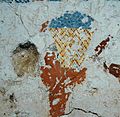Decoration
The tomb of Ineni as part of an earlier group of tombs from the time of Tuthmosis III, which were decorated using a blue background color. This may be an imitation of nearby color schemes of tombs from the Middle Kingdom. The tomb is known to contain an inscription relating to the role of Hatshepsut as a regent in relation to her step-son Tuthmosis III. The inscription mentions how king Tuthmosis II had gone "forth to heaven, having mingled with the gods." His son Tuthmosis III is then said to have "stood in his place as King of the Two Lands, while Hatshepsut "settled the affairs of the Two Lands". [3]
The tomb retains some of its decoration. The rear of the pillars show a variety of scenes:
- The southernmost pillar of which has hunting scenes, in which Ineni was depicted running (his figure has been largely destroyed) with a bow, hunting with dogs and catching a female Hyena.
- The next column shows Ineni in an orchard and garden. [4]
- The third column shows Ineni seated before offerings, including baskets of grapes, bread, meat, vases of wine, etc.
- The fourth pillar shows similar scenes but the decoration is largely destroyed.
- The fifth pillar show Ineni in fields, sowing and plowing and pulling an ax.
- The sixth and final pillar on the north shows the harvest. Grain is heaped, oxen are threshing the grain, and corn is carried off the field. [1]
The gallery further shows Ineni with his staff and contains two stela with an autobiographical text. Ineni is shown with his attendants doing inspections. One scene shows the weighing of the treasure of Amun and records a list of temples. In another scene Ineni is again shown doing inspections. Scenes include the transportation of produce to the temple of Amun. Ineni is depicted with his wife while fishing and fowling, the scenes show hippopotamus, birds and fish. [1]
The passage to the inner chamber depicts Ineni before the gods and records rites that were performed before the statues of Ineni. Ineni's brother Pahery is shown offering to Ineni and his wife. Other scene sinclude a pilgrimage to Abydos, a sarcophagus being dragged by oxen and a funeral procession.
The inner chamber is decorated with scenes of Ineni and his family receiving offerings. The chamber ends with a group of four statues, depicting Ineni, his wife Thuau, his father, also called Ineni, and his mother.






